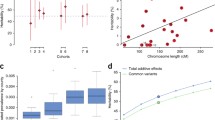Abstract
Parents may respond in various ways to the birth of a seriously affected child. They may, for example, decide not to have any more children or to have one more child and then stop. These various responses are called “stoppage rules” in the genetic literature. Where stoppage rules are operative, the order in which affected and nonaffected children are born is disturbed in definite ways. The present paper shows that stoppage rules are at work in a recently reported data set consisting of 46 multiplex families of childhood autism and, as a consequence, that the segregation ratio was underestimated in the original report. The implications of these results for genetic studies of autism are then discussed.
Similar content being viewed by others
References
Ando, H., & Tsuda, K. (1975). Intrafamilial incidence of autism, cerebral palsy, and mongolism.Journal of Autism and Developmental Disorders, 5, 267–274.
Cavalli-Sforza, L. L., & Bodmer, W. F. (1971).The genetics of human populations, San Francisco: Freeman.
Creak, M., & Ini, S. (1960). Families of psychotic children.Journal of Child Psychology and Psychiatry, 1, 156–175.
Fisher, R. A. (1934). The effect of methods of ascertainment upon the estimation of frequencies.Annals of Eugenics (London), 6, 13–25.
Fuller, J. L., & Thompson, W. R. (1960).Behavior genetics. New York: Wiley.
Granville-Grossman, K. L. (1966). Birth order and schizophrenia.British Journal of Psychiatry, 112, 119–126.
Haldane, J. B. S. (1938). The estimation of the frequency of recessive conditions in man.Annals of Eugenics (London), 8, 255–262.
Hanson, D. R., & Gottesman, I. I. (1976). The genetics, if any, of infantile autism and childhood schizophrenia.Journal of Autism and Developmental Disorders, 6, 209–214.
Hare, E. H., & Price, J. S. (1970). Birth rank and schizophrenia.nature, 228, 1223–1224.
Hinshelwood, R. D. (1968). Schizophrenic birth order: The last but one position.Nature, 220, 490.
Hinshelwood, R. D. (1970). The evidence for a birth order factor in schizophrenia.British Journal of Psychiatry, 117, 293–301.
Jones, M. B. (1957). An addition to Schaeffer and Levitt's “Kendall's tau.”Psychological Bulletin, 54, 158–160.
Kolvin, I., Ounsted, C., Richardson, L. M. & Garside, R. F. (1971). The family and social background in childhood psychoses, III.British Journal of Psychiatry, 118, 396–402.
Li, C. C., & Mantel, N. (1968). A simple method of estimating the segregation ratio under complete ascertainment.American Journal of Human Genetics, 20, 61–81.
Morton, N. E. (1962). Segregation and linkage. In W. J. Burdette (Ed.),Methodology in human genetics. San Francisco: Holden Day.
Morton, N. E., & Mi, M. P. (1968). Multiplex families with two or more probands.American Journal of Human Genetics, 20, 361–367.
Pitfield, M., & Oppenheim, A. N. (1964). Child rearing attitudes of mothers of psychotic children.Journal of Child Psychology and Psychiatry, 5, 51–57.
Ritvo, E. R., Spence, M. A., Freeman, B. J., Brothers, A. M., Mo, A., & Marazita, M. L. (1985). Evidence for autosomal recessive inheritance in 46 families with multiple incidences of autism.American Journal of Psychiatry, 142, 187–192.
Rutter, M., & Lockyer, L. A. (1967). A five to fifteen year follow-up study of infantile psychoses.British Journal of Psychiatry, 113, 1169–1182.
Siegel, S. (1956).Nonparametric statistics for the behavioral sciences. New York: McGraw-Hill.
Stanley, F., & Alberman, E. (1984).The epidemiology of the cerebral palsies (Clinics in Developmental Medicine, No. 87). Philadelphia: Lippincott.
Tsai, L. Y., & Stewart, M. A. (1983). Etiological implications of maternal age and birth order in infantile autism.Journal of Autism and Developmental Disorders, 13, 57–65.
Author information
Authors and Affiliations
Additional information
McMaster University Medical Center
Rights and permissions
About this article
Cite this article
Jones, M.B., Szatmari, P. Stoppage rules and genetic studies of autism. J Autism Dev Disord 18, 31–40 (1988). https://doi.org/10.1007/BF02211816
Issue Date:
DOI: https://doi.org/10.1007/BF02211816




